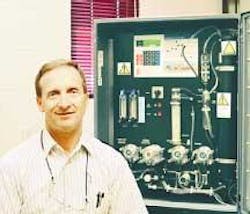On-Line TOC Analyzer Helps Improve Water Treatment
Snowmelt from the Sierra-Nevada mountain range supplies fresh water from north to south along California's semi-arid coastline to the California State Water Project, a water storage and delivery system of reservoirs, aqueducts, power plants and pumping plants.
This waterway system ensures that a continuous, year-round supply of drinking water is provided to semi-arid environments that experience long dry spells during the summer months. However, despite its pristine origins, potential danger lurks in the form of natural organic matter (NOM), typically characterized as microbial degradation of organic matter, decomposing vegetation, and humic soil matter.
The North Bay Aqueduct (NBA), routed westward along the Sacramento River delta and upper San Francisco Bay, provides fresh drinking water to several communities including 28,000-strong Benicia, CA. In operation since 1971, the City of Benicia water treatment plant distributes an average of 6.5 mgd to the community, with peak summer demands as high as 10 mgd. Like many other communities across the United States, Benicia's public works department began revising strategies for drinking water collection, disinfection, and distribution in order to attain and maintain compliance with federal standards described in the 1996 Safe Drinking Water Act and enforced through the United States Environmental Protection Agency's Disinfection Byproduct Ruling (DBP/R).
Amongst these strategies is a high efficiency removal of NOM from the supply water through a process known as "enhanced coagulation." A major component of DBP/R, enhanced coagulation is the result of many years of development by the EPA as a means of minimizing the impact of disinfection by chlorine dosing. The amount of dissolved organic acids in the feed water can be easily determined by measuring total organic carbon (TOC). In fact, all water plants using surface water to produce drinking water are required to monitor the amount of TOC removed by the coagulation process. Monitoring TOC reduces the risk of producing potentially carcinogenic compounds in the distribution system.
In water treatment, metal salts and polymers can be used to remove particulate matter and dissolved organic compounds. In Benicia, this can be a challenging task during the winter rainy season because high waters run faster, resulting in a major flush of organic debris through the watershed.
"We saw the true value of trending the TOC with an on-line analyzer during heavy rainstorms last winter," said Scott Rovanpera, Superintendent of the city's water treatment plant. "Our TOC analyzer tracked the storm runoff so that our operators knew when to adjust the alum."
Rovanpera said that for his operation, TOC values open the door for interpreting coagulant demand for incoming waters. The utility is using a Teledyne Isco EZTOC II on-line TOC analyzer.
"It's the final piece of the puzzle. Without our TOC monitor we would be hard pressed to reliably and efficiently operate our coagulation process. For example, we wouldn't be able to explain why a turbidity of 20 NTU requires 120 mg/l of alum. Now we have learned that we can factor our TOC raw water analysis values with data from the streaming current detector to determine and justify coagulant dosing rates," Rovanpera said.
The TOC analyzer is equipped with a dual stream sample selector.
"Instead of having two different instruments, our operators can program the EZTOC II to alternate between the raw source water and the finished product and it will automatically calculate TOC removal based on the EPA's guidelines. We can even input the alkalinity concentration to determine the correct removal efficiency. As an added feature, we use the instrument's auxiliary (manual) sample inlet to qualify jar tests and to analyze grab samples from various spots within the system," he said.
Although Rovanpera said the treatment process is running more efficiently after installation of the on-line TOC analyzer, he stressed that saving money was a side benefit and not the original focus of their equipment purchase.
"Like any other water superintendent, my commitment to this community is to provide the highest quality finished product to consumers while maintaining a reasonable cost for our ratepayers. We determined that the added capability to monitor TOC in raw waters helps us meet those obligations on a year-round basis," he said.

